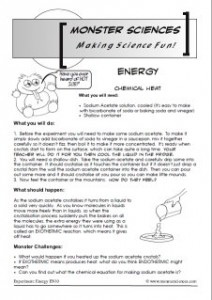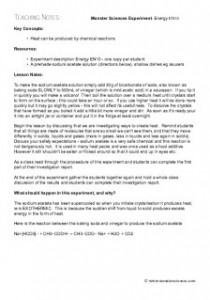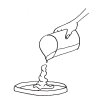Have you ever heard of hot ice? Find out all about how chemicals can create heat in this chemistry science experiment.
 |
 |
An experiment about chemistry: Chemical heat
What you will need:
- Sodium Acetate solution, cooled (it’s easy to make with bicarbonate of soda or baking soda and vinegar)
- Shallow container
What you will do:
- Before the experiment you will need to make some sodium acetate. To make it simply slowly add bicarbonate of soda to vinegar in a saucepan, mix it together carefully so it doesn’t fizz, then boil it to make it more concentrated. It’s ready when crystals start to form on the surface, which can take quite a long time. Your teacher will do it for you then cool the liquid in the fridge.
- You will need a shallow dish. Take the sodium acetate and carefully drip some into the container. It should crystalise as it touches the container but if it doesn’t just drop a crystal from the wall the sodium acetate container into the dish. Then you can pour out some more and it should crystalise at you pour so you can make little mounds.
- Now feel the container or the mountains. How do they feel?
What should happen:
As the sodium acetate crystalises it turns from a liquid to a solid very quickly. As you know molecules in liquids move more freely than in liquids, so when the crystalisation process suddenly puts the brakes on all the molecules, the extra energy they were using as a liquid has to go somewhere so it turns into heat. This is called an EXOTHERMIC reaction, which means it gives off heat.
Monster Challenges:
- What would happen if you heated up the sodium acetate crystals?
- If EXOTHERMIC means produces heat, what do you think ENDOTHERMIC might mean?
- Can you find out what the chemical equation for making sodium acetate is?
Teaching Notes:Monster Sciences Experiment: Energy EN10
Key Concepts:
• Heat can be produced by chemical reactions
Resources:
• Experiment description Energy EN10 – one copy per student.
• A premade sodium acetate solution (directions below), shallow dishes eg saucers
Lesson Notes:
To make the sodium acetate solution simply add 30g of bicarbonate of soda, also known as baking soda SLOWLY to 500mL of vinegar (which is mild acetic acid) in a saucepan. If you tip it in quickly you will make a volcano! Then boil the solution over a medium heat until crystals start to form on the surface – this could take an hour or so. If you use higher heat it will be done more quickly but it may go slightly yellow – this will not affect its usefullness. To dissolve the crystals that have formed as you boiled it add a little bit more vinegar and stir. As soon as it’s ready pour it into an airtight jar or container and put it in the fridge at least overnight.
Begin the lesson by discussing that we are investigating ways to create heat. Remind students that all things are made of molecules that are so small we can’t see them, and that they move differently in solids, liquids and gases (more in gases, less in liquids and less again in solids). Discuss your safety expectations – sodium acetate is a very safe chemical and this reaction is not dangerously hot. It is used in many heat packs and was once used as a food additive. However it still shouldn’t be eaten or flicked around so that it could end up in eyes etc.
As a class read through the procedure of this experiment and students can complete the first part of their investigaton report.
At the end of the experiment gather the students together again and hold a whole class discussion of the results and students can complete their investigation report. What should happen in this experiment, and why? The sodium acetate has been supercooled so when you initiate crystalisation it produces heat, ie is EXOTHERMIC. This is because the sudden shift from liquid to solid produces excess energy in the form of heat. Here is the reaction between the baking soda and vinegar to produce the sodium acetate: Na+[HCO3]– + CH3–COOH → CH3–COO– Na+ + H2O + CO2



